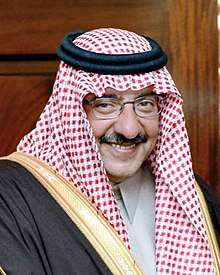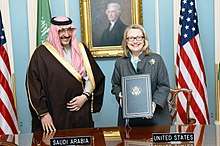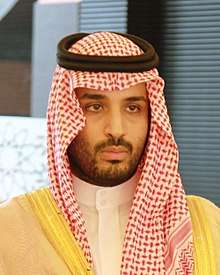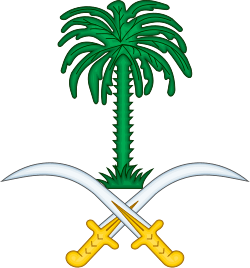Muhammad bin Nayef
| Muhammad bin Nayef Al Saud | |||||
|---|---|---|---|---|---|
 Prince Muhammad in 2013 | |||||
| Crown Prince of Saudi Arabia First Deputy Prime Minister | |||||
| In office | 29 April 2015 – 21 June 2017 | ||||
| Predecessor | Muqrin bin Abdulaziz | ||||
| Successor | Mohammad bin Salman | ||||
| Monarch | Salman | ||||
| Minister of Interior | |||||
| In office | 5 November 2012 – 21 June 2017 | ||||
| Predecessor | Ahmed bin Abdulaziz | ||||
| Successor | Abdulaziz bin Saud Al Saud | ||||
| Deputy Crown Prince of Saudi Arabia Second Deputy Prime Minister | |||||
| In office | 23 January 2015 – 29 April 2015 | ||||
| Predecessor | Muqrin bin Abdulaziz | ||||
| Successor | Mohammad bin Salman | ||||
| Monarch | Salman | ||||
| Born |
30 August 1959 Jeddah, Saudi Arabia | ||||
| Spouse | Reema bint Sultan Al Saud | ||||
| |||||
| House | House of Saud | ||||
| Father | Prince Nayef bin Abdulaziz Al Saud | ||||
| Mother | Al Jawhara bint Abdulaziz bin Musaed bin Jiluwi | ||||
| Religion | Wahhabi Hanbali Sunni Islam | ||||
Muhammad[lower-alpha 1] bin Nayef[lower-alpha 2] Al Saud (Arabic: محمد بن نايف بن عبد العزيز آل سعود; born 30 August 1959) is a prominent member of the House of Saud. He is a nephew of King Salman and grandson of the founding monarch King Abdulaziz.[1][2] He has served as First Deputy Prime Minister and Minister of Interior of Saudi Arabia[3] and chairman of the Council for Political and Security Affairs.[4] On 29 April 2015, he was appointed Crown Prince by King Salman, making him first in line to the throne of Saudi Arabia. On 21 June 2017 he was replaced as Crown Prince and First Deputy Prime Minister by the king’s son, then Deputy Crown Prince Mohammad bin Salman,[5] and relieved of all positions by royal decree of King Salman.[6][7]
Early life and education
Prince Muhammad was born in Jeddah on 30 August 1959.[2][8] He is the second-oldest son and one of ten children of Prince Nayef.[9][10] He has an older brother, Prince Saud, and a younger brother, Prince Fahd.[11] Their mother is Al Jawhara bint Abdulaziz bin Musaed Al Jiluwi,[10][12] who is a member of the Al Jiluwi branch of the House of Saud.[13]
Muhammad's father Nayef was one of the Sudairi Seven, a power bloc of sons of the kingdom's founder, King Abdelaziz (known in the West as Ibn Saud), and Hussa bint Ahmed Al Sudairi. Thus, Prince Muhammad was born to an especially privileged position in the House of Saud dynasty: a paternal grandson of the founding monarch, and child of one of the original king's favourite sons. Two of Prince Muhammad's full uncles, Fahd and Salman, have reigned as King during Muhammad's lifetime.
Muhammad bin Nayef studied in the United States.[14] He took courses at Lewis & Clark College but did not receive a degree.[15] He attended the FBI's security courses from 1985 to 1988, and trained with Scotland Yard's anti-terrorism units from 1992 to 1994.[9]
Career

Muhammad bin Nayef was appointed assistant interior minister for security affairs in 1999. He had been a businessman before this appointment.[16] He was widely credited for the success of the Ministry's counter-terrorism program.[17] He was also regarded as the architect of the government's counter-insurgency program.[18] He also served as the director of civil defense during his term as assistant minister.[19] He was considered to be an effective assistant interior minister.[20]
In 2004, he was appointed to the rank of minister, becoming number two at the Ministry of Interior.[9] In October 2010, he warned the U.S. Deputy National Security Adviser of the 2010 cargo plane bomb plot.[21][22] After the appointment of Prince Ahmed bin Abdulaziz Al Saud as interior minister upon the death of Prince Nayef in July 2012, Prince Muhammad became deputy interior minister.[1][23]
In November 2009, King Abdullah appointed Muhammad as a member of the influential Supreme Economic Council of Saudi Arabia.[24] This move was regarded as approval of the increase in then-Crown Prince Nayef's power by King Abdullah.[25] On the other hand, this appointment enabled Prince Muhammad to extend his influence over the government's economy policy.[26]
On 5 November 2012, King Abdullah issued a royal decree and dismissed Prince Ahmed, Minister of Interior, from his office and appointed Prince Muhammad as minister.[1] He became the tenth interior minister of Saudi Arabia.[27] Prince Muhammad took the oath of office in front of King Abdullah on 6 November 2012.[28] His appointment was not regarded very positively by human rights activists due to Prince Muhammad's professional experience as a tough enforcer who imprisoned thousands of suspected troublemakers in Saudi Arabia.[29] However, he was regarded as less corrupt and less likely to abuse his power in comparison to other senior princes of his generation.[29]
Prince Muhammad met with British Prime Minister David Cameron in January 2013.[30] He then met with U.S. President Barack Obama in Washington, D.C. on 14 January 2013.[31] They discussed issues of security and regional developments.[31] In late January 2013, Prince Muhammad announced that Saudi women would be allowed to work at the directorate.[32]
In February 2014, Prince Muhammad replaced Bandar bin Sultan, then intelligence chief of Saudi Arabia, and was placed in charge of Saudi intelligence in Syria.[33] Muhammad was assisted in this effort by Prince Mutaib bin Abdullah, the minister of the Saudi Arabian National Guard.[34]
On 10 February 2017, the U.S. Central Intelligence Agency (CIA) granted its "George Tenet Medal" to Bin Nayef for what the agency called his "excellent intelligence performance, in the domain of counter-terrorism and his unbound contribution to realize world security and peace". The medal, named after George Tenet, CIA's longest-serving director, from 1996 to 2004, was handed to him by the newly appointed CIA director Mike Pompeo during a reception ceremony in the Saudi capital Riyadh in the presence of Minister of Defense Mohammad bin Salman Al Saud. It was the first reaffirmation of ties between the Islamic monarchy and United States since President Donald Trump took office on 20 January 2017.[35] The reception was attended by senior civil and military officials and by the U.S. Charge d'affaires to the Kingdom, Christopher Hensel. Bin Nayef and Pompeo discussed security with Turkish officials, he said Saudi Arabia's relationship with the U.S. is "historic and strategic" and added that the move shows Washington's recognition of what he called Riyadh's anti-terrorism efforts.[36]
Deputy Crown Prince
On 23 January 2015 it was announced that King Salman had appointed Muhammad bin Nayef as deputy crown prince.[37][38] The announcement reportedly helped calm fears of dynastic instability over the line of succession.[39] Thus, Prince Muhammad became the first of his generation to be officially in line for the throne. In addition to his other posts Prince Muhammad was named the chair of the Council for Political and Security Affairs which was established on 29 January 2015.[38]
War in Yemen
As chair of the Council for Political and Security Affairs, the Prince was a leading commander of Operation Decisive Storm, the first major Saudi military operation of the 21st century.
Crown Prince
.jpg)
On 29 April 2015, Muhammad bin Nayef was named Crown Prince, replacing Muqrin bin Abdulaziz in the post.[40]
Ouster

Muhammad bin Nayef was deposed by royal decree on 21 June 2017, and Mohammad bin Salman was made heir apparent to the throne.[41] Muhammad was also relieved of all positions by royal decree.[7] Abdulaziz bin Saud Al Saud replaced Prince Muhammad as Minister of Interior.[42] The change of succession had been predicted in December 2015 by an unusually blunt and public memo published by the German Federal Intelligence Service,[43][44] for which it was subsequently rebuked by the German government.[45]
According to the New York Times, reports of "current and former United States officials and associates of the royal family" speaking on condition of anonymity, state that the ouster of Muhammad bin Nayef and his replacement by Mohammad bin Salman in late June 2017 was not "seamless", but involved Muhammad bin Nayef being "held against his will and pressured for hours to give up his claim to the throne".[46] He was still being confined to his palace as of July 19, 2017.[46] In reply, a Saudi official dismissed these reports as "unfounded and untrue in addition to being nonsense" and a "complete fantasy worthy of Hollywood," according to Reuters news agency.[47]
Views
Muhammad bin Nayef, unlike most of the royal family, actively talks to the media.[48] Concerning the struggle against terrorism, he adopts a policy of the iron fist like his father, Prince Nayef.[26] He, and other decision-making elites, have asserted that terrorism must be treated as a form of crime and fought with ruthless policing methods.[49] Walid Jumblatt described Muhammad bin Nayef as the Saudi equivalent of General Ashraf Rifi, former director-general of Lebanon's Internal Security Forces.[50]
Muhammad bin Nayef was commended by Western intelligence agencies for Saudi Arabia's counterterrorism programs.[48] He called for a "security channel" with the United States to facilitate information exchange. He firmly supported U.S. President Barack Obama in his opposition to the release of detainee interrogation photographs. He thought that Yemen was a "dangerous failed state" and becoming a serious threat to Saudi Arabia. He further believed that Yemeni President Ali Abdullah Saleh was losing control. He suggested a strategy of directly working with Yemeni tribes, condemning terrorism.[51]
He praised General Ashfaq Parvez Kayani, the Chief of Army Staff of Pakistan, as a "good man". He voiced his concerns regarding Iran's nuclear program. He defers foreign policy issues to the King.[52] After his appointment as interior minister, U.S. diplomats argued that he is "the most pro-American minister in the Saudi Cabinet".[53]
Influence
The Economist described Prince Muhammad as energetic and low-key, and stated that he was one of the candidates for the throne when the line of succession passes to the grandsons of King Abdulaziz.[54] He was also considered to be one of the possible contenders after his father's death in June 2012.[55][56] In 2011, Michael Hayden reported that Prince Muhammad was the world's fifth most powerful defender.[57] On 4 March 2016, Muhammad bin Nayef was decorated with the French Legion of Honour by French president François Hollande.[58] In April 2016, Prince Muhammad was named by Time as one of the 100 Most Influential People.[59]
On June 21, 2017, Prince Muhammad bin Nayef was replaced as the heir to the Saudi Kingdom by Prince Mohammad bin Salman in a move considered to be "upending decades of royal custom and profoundly reordering the kingdom’s inner power structure."[60] He also lost his position as interior minister. Over the last 15 years, bin Nayef had been considered Saudi Arabia's most influential security official, maintaining close connections with American and British intelligence communities.[61]
Assassination attempts
Muhammad bin Nayef has escaped four assassination attempts. He was injured in the third attempt, and unhurt in the others.[62]
The third attempt was on 27 August 2009.[62] Muhammad bin Nayef was injured by Abdullah al-Asiri, a suicide bomber linked to Al-Qaeda in the Arabian Peninsula. Al-Asiri spoke to Muhammad bin Nayef a few days prior to the bombing, and expressed a desire to surrender himself to the authorities as part of the country's terrorist rehabilitation program. This was apparently a plot to get admitted to the Prince's palace.[63] Al-Asiri is believed to have traveled to Jeddah from the Yemeni province of Marib. During Ramadan, al-Asiri waited in line at the Prince's palace as a "well-wisher". He exploded a suicide bomb, killing himself, but apparently only slightly injuring Muhammad bin Nayef, who was protected from the full force of the blast by al-Asiri's body.[64][65] The explosive device was hidden inside al-Asiri's rectum[66] and anal canal, which security experts described as a novel technique.[67][68] Such a device has since come to be known as a surgically implanted improvised explosive device (SIIED), or body cavity bomb (BCB).[69] Muhammad bin Nayef appeared on state television with a bandage around two of his fingers on his left hand. He stated, "I did not want him to be searched, but he surprised me by blowing himself up."[70]
According to Bruce Riedel, a former US Central Intelligence Agency officer and director of the Intelligence Project at the Brookings Institution, “the weight of the evidence I have seen is that [bin Nayef] was more injured in the assassination attempt than was admitted." To treat his injuries the prince "got onto a pain killer routine that was very addictive. I think that problem got progressively worse.”[46] According to The New York Times, citing "an associate of the royal family", the prince's alleged addiction was cited to "strengthen support for the sudden change in the line of succession" that removed bin Nayef from office.[46]
This was the first assassination attempt against a royal family member since 2003, when Saudi Arabia faced a sharp uptick in Al Qaeda-linked attacks.[71][72] The last assassination attempt against Prince Muhammad was in August 2010.[62]
Personal life
Muhammad bin Nayef is a son-in-law of and also a full nephew of Sultan bin Abdulaziz. He is also a nephew of King Fahd and King Salman.[54] He is married to Reema bint Sultan Al Saud, his first cousin, and they have two daughters, Princess Sarah and Princess Lulua.[73]
In April 2016, Muhammad bin Nayef was implicated in the Panama Papers leaks.[74]
Ancestry
| Ancestors of Muhammad bin Nayef | |||||||||||||||||||||||||||||||||||||||||||||||||||||||||||||||||||||||||||||||||||||||||||||||||||||||||||||||||||||||||||||||||||||||||||||||||||||||||||||||||||||||||||||||||||||||||||||||||||||||||||||||||||||||||||||||||||||||||||||||||||||||||||||||||||||||||||||||||||||||||||||||||||||||||||||||||||||||||||||||||||||||||||||||||||||||||||||||||||||||||||||||||||||||||||||||||||||||||||||||||||||||||||||||||||||||||||||||||||||||||||||||||||||||||||||||||||||||||||||||||||||||||||||||||||||||||||||||||||||||||||||||||||||||||||||
|---|---|---|---|---|---|---|---|---|---|---|---|---|---|---|---|---|---|---|---|---|---|---|---|---|---|---|---|---|---|---|---|---|---|---|---|---|---|---|---|---|---|---|---|---|---|---|---|---|---|---|---|---|---|---|---|---|---|---|---|---|---|---|---|---|---|---|---|---|---|---|---|---|---|---|---|---|---|---|---|---|---|---|---|---|---|---|---|---|---|---|---|---|---|---|---|---|---|---|---|---|---|---|---|---|---|---|---|---|---|---|---|---|---|---|---|---|---|---|---|---|---|---|---|---|---|---|---|---|---|---|---|---|---|---|---|---|---|---|---|---|---|---|---|---|---|---|---|---|---|---|---|---|---|---|---|---|---|---|---|---|---|---|---|---|---|---|---|---|---|---|---|---|---|---|---|---|---|---|---|---|---|---|---|---|---|---|---|---|---|---|---|---|---|---|---|---|---|---|---|---|---|---|---|---|---|---|---|---|---|---|---|---|---|---|---|---|---|---|---|---|---|---|---|---|---|---|---|---|---|---|---|---|---|---|---|---|---|---|---|---|---|---|---|---|---|---|---|---|---|---|---|---|---|---|---|---|---|---|---|---|---|---|---|---|---|---|---|---|---|---|---|---|---|---|---|---|---|---|---|---|---|---|---|---|---|---|---|---|---|---|---|---|---|---|---|---|---|---|---|---|---|---|---|---|---|---|---|---|---|---|---|---|---|---|---|---|---|---|---|---|---|---|---|---|---|---|---|---|---|---|---|---|---|---|---|---|---|---|---|---|---|---|---|---|---|---|---|---|---|---|---|---|---|---|---|---|---|---|---|---|---|---|---|---|---|---|---|---|---|---|---|---|---|---|---|---|---|---|---|---|---|---|---|---|---|---|---|---|---|---|---|---|---|---|---|---|---|---|---|---|---|---|---|---|---|---|---|---|---|---|---|---|---|---|---|---|---|---|---|---|---|---|---|---|---|---|---|---|---|---|---|---|---|---|---|---|---|---|---|---|---|---|---|---|---|---|---|---|---|---|---|---|---|---|---|---|---|---|---|---|---|---|---|---|---|---|---|---|---|---|---|---|---|---|---|---|---|---|---|---|---|---|---|---|---|---|---|---|---|---|---|---|---|---|---|---|---|---|---|---|---|---|---|---|---|---|---|---|---|---|---|---|---|---|---|---|---|---|---|---|---|---|---|---|---|---|---|---|---|---|---|---|---|---|---|---|---|---|---|---|---|
| |||||||||||||||||||||||||||||||||||||||||||||||||||||||||||||||||||||||||||||||||||||||||||||||||||||||||||||||||||||||||||||||||||||||||||||||||||||||||||||||||||||||||||||||||||||||||||||||||||||||||||||||||||||||||||||||||||||||||||||||||||||||||||||||||||||||||||||||||||||||||||||||||||||||||||||||||||||||||||||||||||||||||||||||||||||||||||||||||||||||||||||||||||||||||||||||||||||||||||||||||||||||||||||||||||||||||||||||||||||||||||||||||||||||||||||||||||||||||||||||||||||||||||||||||||||||||||||||||||||||||||||||||||||||||||||
Notes
- Footnotes
- References
- 1 2 3 "Saudi Arabia's king appoints new interior minister". BBC. 5 November 2012. Retrieved 5 November 2012.
- 1 2 "Council of Ministers: Membership". Royal Embassy, Washington DC. Archived from the original on 16 June 2011. Retrieved 25 January 2015.
- ↑ "Saudi King Salman resolves succession by appointing nephew". The Daily Star. 23 January 2015. Retrieved 23 January 2015.
- ↑ "Massive Cabinet shake-up". 30 January 2015. Retrieved 30 January 2015.
- ↑ "Mohammed bin Salman named Saudi Arabia's crown prince". Al Jazeera. Archived from the original on 21 June 2017.
- ↑ CNN, Nicole Chavez, Tamara Qiblawi and James Griffiths. "Saudi Arabia's king replaces nephew with son as heir to throne". CNN.
- 1 2 Kalin, Stephen (21 June 2017). "Saudi king removes crown prince". The Independent. London.
- ↑ "Royal Grandson Mohammed bin Nayef: A King in Waiting". Al Akhbar. 6 March 2015. Retrieved 21 December 2016.
- 1 2 3 Stig Stenslie (21 August 2012). Regime Stability in Saudi Arabia: The Challenge of Succession. Routledge. p. 39. ISBN 978-1-136-51157-8. Retrieved 7 December 2012.
- 1 2 Caryle Murphy (5 June 2008). "The heir apparent". Global Post. Retrieved 5 May 2012.
- ↑ "Saudi king names new governor for restive oil region". Jeddah. Reuters. 14 January 2013. Retrieved 14 January 2013.
- ↑ "Family Tree of Nayif bin Abdulaziz bin Abdul Rahman Al Saud". Datarabia. Retrieved 2 May 2012.
- ↑ Joshua Teitelbaum (1 November 2011). "Saudi succession and stability" (PDF). BESA Center. Retrieved 24 April 2012.
- ↑ "Prince Muhammad escapes assassination attempt". SUSRIS. Arab News. 28 August 2009. Retrieved 3 November 2012.
- ↑ So This Saudi Prince Didn't Actually Graduate from Lewis & Clark College Time. 30 January 2015. Retrieved 16 March 2015.
- ↑ Caryle Murphy (10 September 2010). "In Saudi Arabia. A softer approach to fighting terror". Global Post. Retrieved 24 May 2012.
- ↑ "Saudi Succession Developments" (PDF). Foreign Reports Inc. 28 October 2011. Retrieved 25 April 2012.
- ↑ Joshua Teitelbaum (8 December 2010). "King Abdullah's Illness and the Saudi Succession". Jerusalem Center for Public Affairs. Retrieved 26 April 2012.
- ↑ "CDO Grants Prince Ahmed bin Abdulaziz Medal of Commander". Gulf in the Media. Riyadh. Saudi Press Agency. 4 October 2009. Retrieved 10 November 2012.
- ↑ Christopher M. Davidson (21 February 2011). "Lords of the Realm". Foreign Policy. Retrieved 26 April 2012.
- ↑ Mark Mazzetti; Robert F. Worth (30 October 2010). "U.S. Sees Complexity of Bombs as Link to Al Qaeda". The New York Times.
- ↑ Jeremy M. Sharp (3 March 2011). "Yemen: Background and U.S. Relations" (PDF). Congressional Research Service. Retrieved 1 June 2012.
- ↑ "Changes in Saudi Arabia and Syria". Middle East in Focus. Commentary. 2013. Retrieved 19 April 2013.
- ↑ "Royal Decree to add Prince Saud Al Faisal, Prince Mohammed bin Naif". Kingdom of Saudi Arabia Supreme Economic Council. 16 November 2009. Archived from the original on 21 September 2013. Retrieved 29 April 2012.
- ↑ Anne-Beatrice Clasmann (20 November 2009). "Discreetly, Saudis speculate about the throne succession". M&C News. Retrieved 29 April 2012.
- 1 2 "The Al Saud succession challenge". AMEinfo. 17 July 2012. Archived from the original on 19 July 2012. Retrieved 17 July 2012.
- ↑ "Profile: Saudi Interior Minister Prince Mohammed bin Naif". Asharq Alawsat. 6 November 2012. Archived from the original on 15 February 2013. Retrieved 1 February 2013.
- ↑ "Prince Muhammad takes oath of office". MENAFN. Arab News. 7 November 2012. Archived from the original on 24 January 2015. Retrieved 10 November 2012.
- 1 2 "The younger generation, at last?". The Economist. 10 November 2012. Retrieved 8 December 2012.
- ↑ Simon Henderson (14 January 2013). "Leadership Change in Oil-Rich Saudi Province". The Washington Institute. Retrieved 3 April 2013.
- 1 2 "Obama's Meeting with Saudi Arabia's Prince Mohammed bin Nayef" (Press Release). US Office of the Press Secretary. Washington DC. 14 January 2013. Retrieved 1 February 2013.
- ↑ "Saudi women allowed to work for intelligence agency". Al Akhbar. 29 January 2013. Retrieved 10 February 2013.
- ↑ Thomas W. Lippman (16 April 2014). "Saudi Intel Chief Prince Bandar Is Out, But Is He Really Out?". Middle East Institute. Retrieved 14 July 2014.
- ↑ Simon Henderson (21 February 2014). "Saudi Arabia's Domestic and Foreign Intelligence Challenges". Washington Institute for Near East Policy. Retrieved 24 February 2014.
- ↑ Bethan McKernan: CIA awards Saudi crown prince with medal for counter-terrorism work, The Independent, 10 February 2017
- ↑ CIA honors Saudi Crown Prince for efforts against terrorism, Al Arabiya English, 10 February 2017
- ↑ "New Saudi Deputy Crown Prince marks generational shift". Reuters. Retrieved 23 January 2014.
- 1 2 Simeon Kerr (30 January 2015). "Saudi king stamps his authority with staff shake-up and handouts". Financial Times. Riyadh. Retrieved 1 February 2015.
- ↑ "Saudi Arabia acts fast on succession after king's death". MSN. 23 January 2015. Archived from the original on 23 January 2015. Retrieved 23 January 2015.
- ↑ "Saudi king replaces crown prince in cabinet reshuffle". Al Jazeera. Al Jazeera Media Network. 29 April 2015. Retrieved 29 April 2015.
- ↑ "Mohammed bin Salman named Saudi Arabia's crown prince: Saudi king replaces first in line to the throne with his son, Mohammed bin Salman, the defence chief, state media says". Al Jazeera. Al Jazeera Media Network. 21 June 2017.
- ↑ "PROFILE: New Saudi Interior Minister Prince Abdulaziz bin Saud bin Nayef". Al Arabiya English. Al Arabiya Network. 21 June 2017. Retrieved 24 June 2017.
- ↑ Justin Huggler (2 December 2015). "Saudi Arabia 'destabilising Arab world', German intelligence warns". The Telegraph.
- ↑ Patrick Cockburn (21 June 2017). "Prince Mohammed bin Salman: Naive, arrogant Saudi prince is playing with fire:German intelligence memo shows the threat from the kingdom's headstrong defence minister". The Independent.
- ↑ Alison Smaledec (3 December 2015). "Germany Rebukes Its Own Intelligence Agency for Criticizing Saudi Policy". The New York Times.
- 1 2 3 4 HUBBARD, BEN; MAZZETTI, MARK; SCHMITT, ERIC (18 July 2017). "Saudi King's Son Plotted Effort to Oust His Rival". New York Times. Retrieved 19 July 2017.
- ↑ "Saudi official dismisses palace coup report as Hollywood fantasy". Reuters. 19 July 2017. Retrieved 19 July 2017.
- 1 2 "Saudi Arabia's ambitious Al Qaida fighter". MSNBC. 11 July 2005. Retrieved 30 September 2009.
- ↑ Amir Taheri (2004). "Saudi Arabia: Between Terror and Reform" (PDF). American Foreign Policy Interests: 457–465. doi:10.1080/10803920490905523. Archived from the original (PDF) on 21 September 2013. Retrieved 15 April 2012.
- ↑ "Jumbulatt recounts Suadi trip, Money problems, Syrian threats". Al Akhbar. 11 July 2006.
- ↑ "Special Advisor Holbrooke's' meeting with Saudis". Wikileaks. 17 May 2009. Retrieved 27 May 2012.
- ↑ "Saudi Arabia: General Jones". Wikileaks. 19 January 2010. Retrieved 27 May 2012.
- ↑ "Obama meets pro-U.S. young Turk in aging Saudi cabinet". World Tribune. Washington. 15 January 2013. Archived from the original on 5 April 2013. Retrieved 19 April 2013.
- 1 2 "Time, surely, for a much younger one". The Economist. 29 October 2011. Retrieved 26 April 2012.
- ↑ Abdullah Al Shihri; Brian Murphy (17 June 2012). "Death of Saudi prince moves younger generation toward crown". Times Colonist. Associated Press. Retrieved 17 June 2012.
- ↑ Thomas W. Lippman (16 June 2012). "Saudi Arabia Moves Closer to A New Generation of Leaders". Al Monitor. Retrieved 17 June 2012.
- ↑ "Michael Hayden: The World's 7 Most Powerful Defenders And Offenders". Forbes. 11 February 2011. Retrieved 3 November 2012.
- ↑ "France awards Legion d'Honneur to Saudi prince 'for terror fight'". The Guardian.
- ↑ "Relentless campaign against Al-Qaeda gets crown prince Time honor". Arab News. Jeddah. 22 April 2016. Retrieved 22 April 2016.
- ↑ "Saudi King Rewrites Succession, Replacing Heir With Son, 31". New York Times. Retrieved 29 June 2017.
- ↑ "Deposed Saudi crown prince confined to palace". The Guardian. Retrieved 29 June 2017.
- 1 2 3 Abdullah Al Oraifij (16 August 2010). "Fourth assassination attempt against Prince foiled". Saudi Gazette. Riyadh. Archived from the original on 22 August 2010. Retrieved 19 April 2013.
- ↑ Kevin Sullivan (23 January 2015). "Meet the Saudi royal family's rising star, Prince Mohammed bin Nayef". The Washington Post. Riyadh. Retrieved 23 January 2015.
- ↑ Michael Slackman (28 August 2009), "Would-Be Killer Linked to Al Qaeda, Saudis Say", The New York Times, retrieved 13 May 2010
- ↑ "Saudi prince spoke to bomber on phone before attack". Reuters. 2 September 2009. Archived from the original on 2 September 2009.
- ↑ Panetta, Leon (2014). Worthy Fights. Penguin Press. p. 244. ISBN 978-1-59420-596-5.
- ↑ "Saudi suicide bomber hid IED in his anal cavity", Homeland Security Newswire, September 9, 2009
- ↑ "Saudi Bombmaker Key Suspect in Yemen Plot". CBS News. Associated Press. November 1, 2010. Retrieved 24 April 2015.
- ↑ Bunker, R. J. Flaherty, C. (2013). Body Cavity Bombers: The New Martyrs. A Terrorism Research Center Book. iUniverse, Inc. Bloomington, 2013.
- ↑ "Saudi prince wounded by suicide bomber vows to fight Al-Qaida". Haaretz. 28 August 2009. Retrieved 24 May 2012.
- ↑ "King commended the efforts of the Prince in the service of country and religion" (in Arabic). Al Arabiya. 28 August 2009. Retrieved 30 September 2009.
- ↑ "Al Qaeda claims Saudi prince bomb". BBC. 30 August 2009. Retrieved 3 November 2012.
- ↑ "Profile: Prince Mohammed bin Naif bin Abdulaziz Al-Saud". Al Arabiya. 27 January 2015. Retrieved 31 October 2015.
- ↑ "A world tour of the politicians named in the Panama Papers". France 24. 5 April 2016.
- ↑ "Family Tree of Muhammad bin Nayef bin Abdulaziz Al Saud". Datarabia. Retrieved 24 May 2012.
External links

| Saudi Arabian royalty | ||
|---|---|---|
| Preceded by Muqrin |
Crown Prince of Saudi Arabia 28 April 2015 – 21 June 2017 |
Succeeded by Mohammad bin Salman |
| Political offices | ||
| Preceded by Ahmed bin Abdulaziz |
Minister of the Interior 5 November 2012 – 21 June 2017 |
Succeeded by Abdulaziz bin Saud Al Saud |
| Preceded by Muqrin bin Abdulaziz |
Second Deputy Prime Minister 23 January 2015 – 28 April 2015 |
Succeeded by Muhammad bin Salman |
| First Deputy Prime Minister 28 April 2015 – 21 June 2017 | ||

